- Home
- Stephen E. Ambrose
Ike's Spies Page 12
Ike's Spies Read online
Page 12
Security for OVERLORD included keeping the Germans from discovering the various new devices on which the Allies were counting for success, such as artificial harbors and swimming tanks. If the Germans learned about Mulberry (code name for concrete platforms to be floated across to Normandy, then sunk to create an artificial port), they would know that the Allies were coming across an open beach, not directly at a port city. ULTRA and the Double-Cross System combined to tell Eisenhower that the Germans were unsuspecting; there was nothing about the artificial ports on German radio, and the spy masters in Berlin were not asking their spies in England for any information about Mulberry.33
These devices were but small aspects of the larger scene. World War II, as the phrase has it, was fought in large part on the drawing boards. All the nations involved were striving frantically to make technological breakthroughs. By far the most important of these was the development of the atomic bomb. In the United States the Manhattan Project, under General Leslie Groves, was making rapid progress toward its objective, but Groves and several of the leading scientists on the project were worried about the possibility of the Germans using radioactive poisons against the OVERLORD forces. Groves told Marshall there was a remote chance of it happening, and Marshall sent Arthur Peterson of the Manhattan Project to London to see Ike and explain the danger to him. Peterson emphasized the need for secrecy so strongly, however, there was little Ike could do to meet the possible threat. He did not brief his senior commanders, but he did have the medical channels informed about symptoms.34
IN MID-MAY, Eisenhower ordered the concentration of the assault force near the invasion ports in southern England. The enormous heaps of supplies that had been gathered and stored throughout the United Kingdom then began the final move, carried by unending convoys to the south, filling all available warehouses, overflowing into camouflaged fields. Hundreds of thousands of men meanwhile traveled to tented areas in the southern counties. They were completely sealed off from the rest of the world, with barbed-wire fences stretching around their camps, keeping all the troops in and all civilians out. Some two thousand Counter Intelligence Corps men guarded the area. Camouflage was everywhere, for this was the most tempting and profitable military target in Europe, and the Germans were known to be on the verge of making their V weapons operational.
Within the encampment, the men received their final briefings. For the first time they learned they were going to Normandy. They pored over foam-rubber models of the beaches, examined photographs, were made familiar with landmarks, were assured of overwhelming naval and air support, and finally given the overall picture, the broad outline of OVERLORD. Ike’s men were set to go. “The mighty host,” he later wrote, “was tense as a coiled spring, ready for the moment when its energy should be released and it would vault the English Channel.”35
Everything had been done that could be done. Would the Germans be surprised? The question could not be answered. The last-minute signs could not have been worse. At the end of May the mighty Panzer Lehr Armored Division showed up in Normandy, along with the 21st Panzer Division, which moved from Brittany to Caen, exactly to the site where the British Second Army would be landing. Even more alarming, ULTRA revealed that the German 91st Divison, specialists in fighting paratroopers, and the German 6th Parachute Regiment had moved on May 29 into exactly the areas where the American 82d and 101st Airborne Divisions were to land the night before D-Day. Finally, the German 352d Division, veterans of the Russian front, had moved forward from St. Lô, at the base of the neck of the Cotentin Peninsula, to the coast, taking up a position overlooking Omaha Beach, where the U. S. First Army was going to land.36
These movements gave everyone the jitters. They caused Ike’s air commander, Leigh-Mallory, to urge Eisenhower to call off the landings of the 82d and 101st for fear they would be destroyed. As Ike later wrote, “It would be difficult to conceive of a more soul-racking problem.”37
He quickly got one. SHAEF had prepared for everything, except the weather. On June 4, a storm roared in from the northwest. Waves and wind were much too high to attempt a landing. Suddenly, the SHAEF weatherman became the most important intelligence officer of all.
*
* Ike’s analysis of Patton, as expressed to Marshall, is worth quoting at length: “Many generals constantly think of battle in terms of first, concentration, supply, maintenance, replacement, and second, after all the above is arranged, a conservative advance. This type of person is necessary because he prevents one from courting disaster. But occasions arise when one has to remember that under particular conditions, boldness is ten times as important as numbers. Patton’s strength is that he thinks only in terms of attack as long as there is a single battalion that can keep advancing. Moreover, the man has a native shrewdness that operates in such a way that his troops always seem to have ammunition and sufficient food no matter where they are. Personally, I doubt that I would ever consider Patton for an army group commander or for any higher position, but as an army commander under a man who is sound and solid, and who has sense enough to use Patton’s good qualities without becoming blinded by his love of showmanship and histrionics, he should do as fine a job as he did in Sicily.”16
* Imposing the ban gave Hitler a useful clue as to the timing of OVERLORD. He remarked in late April that “the English have taken measures that they can sustain for only six to eight weeks.”
CHAPTER SEVEN
D-Day and the French Resistance
JUNE 4, 1944. Group Captain J. M. Stagg of the RAF must provide Ike with the final piece of information he needs to launch OVERLORD—one that no one could control or keep secret. What will the weather be like on D-Day?
TO HELP HIM answer that crucial question, Stagg had six different weather services (American and British land, sea, and air) feeding him information. On the morning of June 4, to his dismay, he had six distinct weather predictions to pick from.
The Germans, too, had their problems in predicting the weather. Stagg explained their predicament in his book Forecast for Overlord: “Deprived of weather reports from the British Isles and the ocean areas to the west and north, German forecasters could be kept in ignorance of the development and movement of weather systems over an area which is always important for forecasting throughout north-western and central Europe—in ignorance, except in so far as the Germans organized their own reports from their own reconnaissance aircraft or submarines, and they were known to go to great lengths to do this.”1
Stagg was the beneficiary of the German effort, because ULTRA picked up the weather reports from German submarines and helped him fill in his charts. He made up his own prediction, one that drew upon all the others but was uniquely his. Despite the intense storm on June 4, Stagg predicted a break in the weather for June 6. Ike trusted his source. He decided to take the risk and go.
THE INVASION WAS UNDER WAY. At 1 A.M. on June 6, 1944, German agent Garbo sent to the Abwehr the most sought-after secret of the war—where and when the invasion was coming. Garbo reported that OVERLORD was on the way, named some of the divisions involved, indicated when they had left Portsmouth, and predicted that they would come ashore in Normandy at dawn.
The report had to be deciphered, read, evaluated, reenciphered, and transmitted to Berlin. There it was deciphered, typed up, and sent to army headquarters, then on to Hitler. The whole process was reversed to get orders out to the German forces on the French coast. The word did not arrive in time to do any good. By the time the Germans got it, they could see 6,000 planes overhead, 5,000 ships off the coast, the first wave of troops coming ashore.
But it surely raised their opinion of Garbo.2
At dawn, June 6, Eisenhower’s mighty host crossed the Channel successfully, hurled itself against the Normandy beaches, and established a beachhead. Paratrooper losses, although heavy, did not approach the 70 percent mark that Leigh-Mallory had predicted. There were many anxious moments along Omaha Beach, where the U. S. 1st Division faced the German 352d Division, bu
t by nightfall of June 6, the Americans were there to stay. The British and Canadian forces also generally achieved their D-Day objectives.
The foul weather had been a positive help to the Allies because the Germans believed the weather was so bad that no invasion could be launched. In fact, due to the weather they canceled the customary air and sea reconnaissance missions that would have warned them of the approaching fleet. A war game at Rennes, attended by a number of army and divisional commanders from the Normandy area, went off on schedule. And Rommel, after studying the weather reports, had gone on leave!
Not one submarine, not one small boat, not one airplane, not one radar set, not one German, anywhere, detected the launching of the largest force of warships in history, or the passage of that fleet—covered by the largest force of airplanes ever assembled—across the Channel. As General Walter Warlimont, deputy chief of operations at German Supreme Headquarters, recorded, on the eve of OVERLORD the leaders of the Wehrmacht “had not the slightest idea that the decisive event of the war was upon them.”3
ONE ASPECT of Eisenhower’s decision to go on June 6 that is seldom mentioned was his fear that if he postponed OVERLORD until the next suitable date (June 16), FORTITUDE might well be compromised. Tens of thousands of Allied soldiers had been told that Normandy was the site; to keep them sealed off from the outside world for two weeks seemed impossible. Further, German air reconnaissance was sure to discover the immense buildup of forces around Portsmouth and southern England. Already Rommel seemed to be reinforcing Normandy and the Cotentin Peninsula. OVERLORD almost had to go on June 6, if it were to go at all.
BY DAWN OF JUNE 7, OVERLORD had achieved its first crucial goal, to get ashore. Now began the second test: Had FORTITUDE convinced the Germans that Normandy was a feint? Rommel and Rundstedt greatly outnumbered Ike on the Continent. If they operated at full tilt, rushing reinforcements into Normandy with maximum speed, they still had plenty of time and opportunity to drive the Allies into the sea. Because the Germans could move by truck, tank, or railroad, while the Allied forces had to journey to the battlefield via ship and landing craft, the advantage was with the Germans. Ike had three weapons to keep the enemy away from the battlefield while he steadily brought in more units from Britain.
One was air superiority. From dawn to dusk, Allied airmen bombed and shot up every enemy column, whether on the roads or on the rails, that was spotted trying to move into Normandy. Eisenhower’s second weapon was the French underground, working in close coordination with SHAEF, against targets designated by Ike, to harass the German columns, blow bridges, create roadblocks, and in countless other ways slow the rate of German movement.
Ike’s third weapon in the battle of the buildup was the cheapest, in terms of men and matériel, and the most successful in terms of keeping German troops away from the battle area. It was a continuation of FORTITUDE, this time with one of the most brazen operations of the war.
On D-Day plus three, June 9, Garbo sent a message to his spy master with a request that it be submitted urgently to the German High Command. “The present operation, though a large-scale assault, is diversionary in character,” Garbo stated flatly. “Its object is to establish a strong bridgehead in order to draw the maximum of our reserves into the area of the assault and to retain them there so as to leave another area exposed where the enemy could then attack with some prospect of success.”
Citing the Allied order of battle, Garbo said that Eisenhower had committed only a small portion of his seventy-five divisions (Ike’s actual total was fifty). He pointed out that no FUSAG unit had taken part in the Normandy attack, nor was Patton there. Further, “The constant aerial bombardment which the sector of the Pas de Calais has been undergoing and the disposition of the enemy forces would indicate the imminence of the assault in this region which offers the shortest route to the final objective of the Anglo-American illusions: Berlin.”4
Within half a day, Garbo’s message was in Hitler’s hands. On the basis of it, the Führer made a momentous decision. Rundstedt had wanted to commit his best division, the 1st SS Panzer Division, together with the 116th Panzer Division, to the battle in Normandy, where Rommel desperately needed reinforcements. They had started for Caen, but now Hitler ordered the armored units back to the Pas de Calais to help the Fifteenth Army defend against the main invasion. He also awarded an Iron Cross, Second Class, to Garbo.5
The Double-Cross System orchestra was now playing at full volume, with every instrument involved. The Germans had great confidence not only in Garbo but in all their spies. Whenever troops of real formations reached France, they were always troops who had been identified and reported on by the agents. As a consequence of finding the reports to be accurate, the Germans naturally believed the reports which concerned the imaginary troops supposedly still stationed in England, poised to hit the Pas de Calais. It was relatively easy to convince the Germans that the real divisions that were coming into Normandy had been shifted from FUSAG to Normandy because of the Allies’ unexpected difficulties in breaking out of the beachhead.
The deception went on. On June 13, an agent warned that another attack would take place in two or three days around Dieppe or Abbeville, near the Pas de Calais. Another agent reported that airborne divisions (wholly fictitious) would drop around Amiens, halfway between Paris and the Pas de Calais.
In late June, agent Tate reported. Masterman had convinced the Germans that he was a man with a genius for making friends in high places—he was the spy who reported Eisenhower’s arrival in London in January—so the Abwehr was not surprised when Tate claimed to have obtained the railway schedule for moving the FUSAG forces from their concentration areas to the embarkation ports, thus reinforcing from a new angle the imminence of the threat to the Pas de Calais. Tate’s report was considered so important by one Abwehr officer that he gave it as his opinion that it could “even decide the outcome of the war.” He was not far wrong.
FORTITUDE had remarkable durability. As Masterman notes, “In German eyes, the threat to the Pas de Calais was as great and dangerous in July as it had been in May. In fact, and beyond the wildest hopes of those responsible, the threat held until the autumn.”6
One of Ike’s greatest pleasures during the first two months of the campaign was to read the weekly intelligence summaries (or, more often, hear Strong’s oral report) on “German appreciation of Allied intentions in the West,” the principle source being ULTRA. Each summary was brief and to the point.
The summary of June 19 read, “The Germans still believe the Allies capable of launching another amphibious operation. The Pas de Calais remains an expected area for attack. Fears of landings in Norway have been maintained. Enemy naval and ground forces have remained unaltered since D-Day.”
On July 10: “So far the enemy’s fear of large scale landings between the Seine and the Pas de Calais has not diminished. The second half of July is given as the probable time for this operation.” Not so good was the report that “German fears of a landing in Southern Norway continue to diminish.”
By July 24, Ike had almost thirty divisions in Normandy and had by then won the battle of the buildup. On that date, the summary was again welcome reading: “The Germans have identified in Normandy some units that they believe to have been part of the army held in readiness for a second major landing between the Seine and the Franco-Belgian frontier. But there has been no considerable transfer of German forces from the Pas de Calais, which remains strongly garrisoned.” The summary did note that one division was moving out of the Pas de Calais, and another from Belgium, both presumably headed for the battle area in Normandy.
The next summary, on July 31, noted that the two divisions had shown up in Normandy “and the last remaining armoured division North of the Seine has now arrived in the battle area. It is likely that these movements have been forced on the enemy by the increasing urgency of battle requirements despite his fears of an Allied landing north of the Seine. Though the enemy now regards such a landing a
s rather less imminent, these fears still remain.”7
By August 3, when Patton came onto the Continent with his U. S. Third Army, most German officers realized that Normandy was the real thing. By then, of course, it was too late. The Germans had kept hundreds of their best tanks and thousands of their finest fighting men (a total of fifteen divisions) out of this crucial battle of the war in order to meet a threat that was always imaginary. Equally remarkable, as Masterman noted, was “that no single case was compromised by the grand deception for OVERLORD, but that, on the contrary, those agents who took a leading part in it were more highly regarded by the Germans after it than before.”8
On October 25, 1944, Colonel John Bevan, the Controlling Officer of Deception and Masterman’s boss, wrote his immediate superior, “When the history of this war is written, I believe it will be found that the German High Command was, largely through the medium of BI-A channels, induced to make faulty dispositions, in particular during the vital post-OVERLORD D-Day period.”9 It was British understatement on a grand scale. To paraphrase Churchill, never had so many been immobilized by so few.
FORTITUDE and the Double-Cross System held the Fifteenth Army in place at the Pas de Calais, but the Germans had other formations in France to draw upon in the battle of the buildup. Again, the role of the air forces in immobilizing these troops cannot be overemphasized, but that story is not part of the secret side of OVERLORD. An equally important role was played by the French underground, and that story is a part of any account of Eisenhower and the intelligence community, for it was in this area that the OSS made its contribution to a successful OVERLORD.

 Undaunted Courage
Undaunted Courage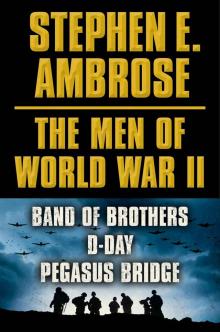 The Victors: Eisenhower and His Boys
The Victors: Eisenhower and His Boys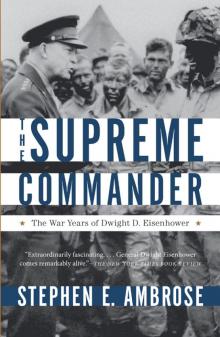 The Supreme Commander
The Supreme Commander Ike's Spies: Eisenhower and the Espionage Establishment
Ike's Spies: Eisenhower and the Espionage Establishment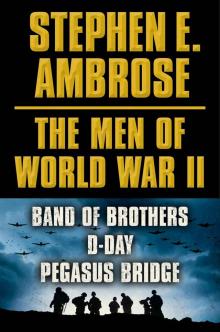 The Men of World War II
The Men of World War II Nothing Like It in the World The Men Who Built the Transcontinental Railroad 1863-1869
Nothing Like It in the World The Men Who Built the Transcontinental Railroad 1863-1869 Ike's Spies
Ike's Spies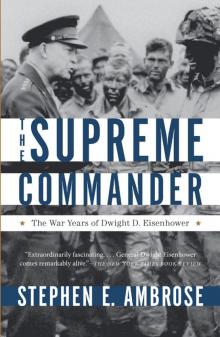 Supreme Commander
Supreme Commander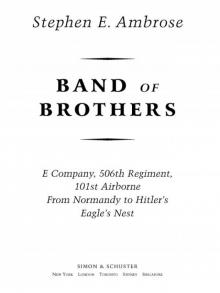 Band of Brothers
Band of Brothers